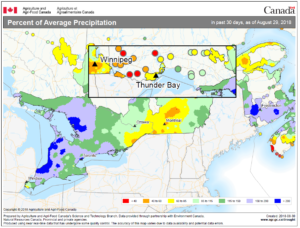Northeastern:
- Dry conditions meant that second cut yield was light. Areas that did not receive adequate rainfall in August may have been unable to take a second cut of hay this year. Pasture is tight, with many producers feeding stored forages.
- As of August 29, most of the region received above average rainfall in the month of August, except for Temiskaming (which had average amounts of precipitation), and Cochrane (60-85% of average) Districts.
- The critical fall harvest period (CFHP) for alfalfa began in mid-August. This rest period improves winter survival and maintains yield potential of productive alfalfa stands. Alfalfa should not be harvested during the six-week period following the date shown on the map.
- If additional forage is needed, cutting alfalfa six weeks or more after the start date of the CFHP will have less impact on next year’s crop than cutting in the middle of the CFHP.
Northwestern:
- Dry conditions meant that second cut yield was light. Areas that did not receive adequate rainfall in August may have been unable to take a second cut of hay this year. Pasture is tight, with many producers feeding stored forages.
- As of August 29, most of the region received below average rainfall in the month of August, with plenty of variability across the northwest.
- The critical fall harvest period for alfalfa began in mid-August. This rest period improves winter survival and maintains yield potential of productive alfalfa stands. Alfalfa should not be harvested during the six-week period following the date shown on the map.
- If additional forage is needed, cutting alfalfa six weeks or more after the start date of the CFHP will have less impact on next year’s crop than cutting in the middle of the CFHP.

Map showing percent of average precipitation in Ontario in August, 2018

Map of start dates for the critical fall harvest period of alfalfa in Ontario
Source : fieldcropnews